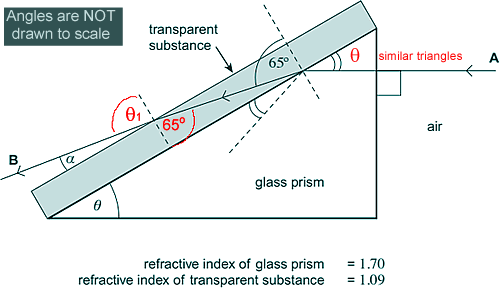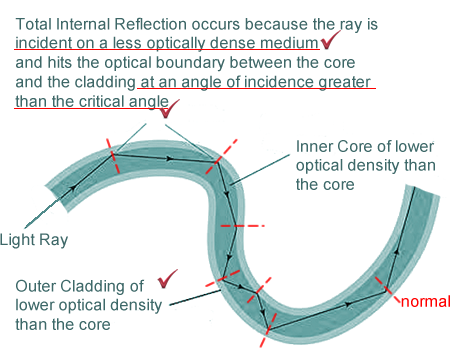Refraction and Total Internal Reflection
Q1.
(a) Tick the appropriate boxes in the table below to indicate how the wavelength, frequency and speed of light are affected when a ray of light travels from air into glass.
| |
wavelength |
frequency |
speed |
| increase |
|
|
|
| stay the same |
|
 |
|
| decrease |
 |
|
 |
 if frequency is correct
if frequency is correct
 if both wavelength and speed are correct
if both wavelength and speed are correct
[2 marks]
(b) The diagram belowshows a right-angled glass prism in contact with a transparent substance on one of the faces. One of the other angles of the prism is θ.

(i) Ray A enters perpendicularly to one face of the prism.
It is partially refracted and partially reflected at the interface between the glass and the transparent substance.
The angle of refraction is 65.0º. The ray eventually leaves at an angle α to the surface of the transparent substance.
Determine the angle α.

Let substance 1 be air,substance 2 be the transparent substance and substance 3 be glass.
n1 = 1.0
n2 = 1.09
n1 sin θ1 = n2 sin θ2
1.0 x sin θ1 = 1.09 x sin 65o 
sin θ1 = 0.9879
θ1 = 81.07o
∴ α = 9.03o 
[2 marks]
(ii) Determine the angle θ
At the glass/transparent substance boundary, the angle of refraction into the substance is 65o.
n3 = 1.70
n2 = 1.09
θ2 = 65o
θ3 = ?
n3 sin θ3 = n2 sin θ2
sin θ3 = 1.09 x sin 65o/1.70
sin θ3 = 0.5811
θ3= 35.5o 
∴θ = 54.5o 
[2 marks]
(c) This new diagram shows another ray entering the prism:

(i) Identify the effect that takes place at X
Total internal reflection 
[1 mark]
(ii) Explain, with a diagram, how the effect that occurs at X is used to transmit information along an optic fibre.

A fibre optic cable comprises of a core surrounded by cladding of a lower optical density; therefore having a lower refractive index than the core. When a light ray enters the cable it hits the boundary between the two optical substances at an angle greater than the critical angle.
therefore having a lower refractive index than the core. When a light ray enters the cable it hits the boundary between the two optical substances at an angle greater than the critical angle.
As the boundary is a dense to rare optical density boundary,  the ray suffers total internal reflection.
the ray suffers total internal reflection.
This is repeated at each incidence point along the cable and results in the light ray being transmitted along the cable with very little loss of energy.
[3 marks]
(Total 10 marks)


